Sep
26
Honor Flight
Filed Under American Patriotism, Events, Healing, Honor Flight, Tears of a Warrior, War | Comments Off on Honor Flight
by Janet J. Seahorn, Ph.D
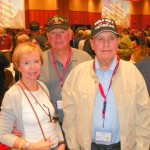
It is early morning Sunday, September 11, 2011 and still dark outside as veterans Earl and Tony Seahorn depart for their long awaited father & son trip to Washington D.C. Veterans from two different wars are about to embark on a patriotic journey of a lifetime. Earl, a WWII Navy veteran, participated in the historic “D-Day” operation at Normandy. Tony, a Vietnam veteran with a Purple Heart was going to be his “guardian” for the trip. Guardians pay their own way to support the WWII and Korean War Honor Flight participants. But when the selection committee discovered that Tony volunteered to support the Wyoming/Northern Colorado Flight, they chose to honor his military service as well. This was the first time Vietnam veterans who have a purple heart have been invited to join the Honor Flight attendees. The pair is one of the first father/son duos to participate together in the Honor Flight program.
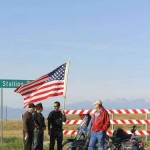
Having so many veterans assembled together, so many experiences good and bad; so much sacrifice all in the name of liberty was humbling. Family members, friends, community groups gathered for the celebration and send off. Because this was the tenth anniversary of 9/11, a moment of silence occurred to mark the time the various planes hit the World Trade Towers, the Pentagon, and Flight 93 that crashed in what is now a sacred field in Shanksville, Pennsylvania.
In the silent room, one could not help but be aware of the high cost of what comes to pass when the United States becomes part of war. To make it even more profound, Sal Gunita, the recent Medal of Honor recipient, spoke to these past warriors and thanked them for their courage, service and sacrifice for our country.
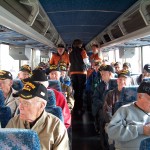
Then the veterans were loaded on four buses for the trip to Denver International Airport where their charter plane was waiting. People lined the outside hotel’s corridor, waving flags and smiling. Horns honked, over one hundred Patriot Guard motorcycle members along with many police, fire department, and sheriff deputy personnel provided an escort. A red and white helicopter hovered over the scene just above a huge American flag fluttering its special salute. As the convoy traveled down the highway, groups gathered on bridges and along roadsides to acknowledge the day and the veteran’s service.
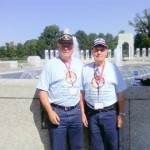
On this tenth anniversary of 9/11 four busloads of warriors began what may be for many one final expedition to visit memorials in our nation’s capital. Memorials dedicated to their service that will forever serve as a visual and silent reminder that Freedom is never Free. For many of these weathered warriors, tears remain in their hearts and souls. For others, they are finally liberated to weep quietly. This time, however, at least some of these tears are not from sorrow, but from gratitude and joy. It is for this reason, we are incredibly appreciative of the many volunteers, donations, and efforts of all those who have made such a huge difference to the many veterans participating in these special Flight of Honor.
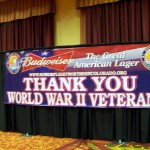
http://www.honorflight.org/about/index.cfm
Sep
20
DOGS CAN’T PLUCK TEARS
Filed Under Dogs, Pets, Plucking Tears | Comments Off on DOGS CAN’T PLUCK TEARS
by Janet J. Seahorn, Ph.D
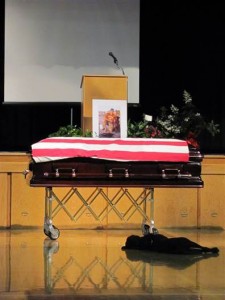
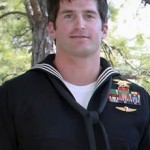
We have written several blogs on the significance of animals in bettering our lives and making our days easier to move through. But what happens when the guardian of our days is left behind? What happens when their beloved human is no longer around to protect, love, and be loved?
When Dog’s can’t “pluck tears” how do they grieve? How do they get over the loss of their best friend? Few of us consider how to support a trusted four-legged companion through the grieving process. Treats won’t take away the ache in the stomach. A walk may be distracting for a time, but it will never be the same without their best friend along. An animal, much like many of us humans, cannot understand or accept the finality of never being with, seeing, or being hugged and stroked by the one person who has been their mainstay for their years on earth. All our four-legged sentinels knows for sure is that special person is not around.
So they wait, and remain hopeful that someday that beloved master will once again appear. Such heartbreak can not be explained to those who are not animal lovers. Only a person who has been blessed to have shared time with a loyal companion will be able to comprehend the massiveness of the loss, the intensity of the sorrow, and the endlessness of the Hope that one day they will meet again to be together.
Today, I ask that you say a prayer of remembrance and peace for all of our animal family that have suffered such a profound loss. I believe somewhere beyond our sight and understanding we are all surrounded by angels of different breeds and types. They hear us, feel our sadness, and enfold us in wings of comfort.
Since we can’t “Pluck their Tears” perhaps we can at least offer a bit of comfort and extra love.
NOTE: Picture is of Jon Tumilson Navy Seal… Died August 6, 2011 and his dog… Labrador retriever “Hawkeye”
Sep
5
PLUCKING TEARS
Filed Under Family, Healing, Life, Peace, Plucking Tears, Tears of a Warrior | Comments Off on PLUCKING TEARS
by Janet J. Seahorn, Ph.D
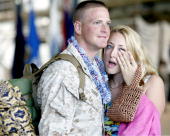
Plucking Tears is not an easy thing to do, especially when the water works fall faster than you can pluck. Another problem to consider is how do you pluck tears when they are inside your heart and soul? These water drops are harder to access. Many times some do not even recognize they are weeping. The suffering is so silent, so hard to define that outsiders rarely, if ever, observe the sobs.
War is an extreme opportunity to frequently pluck tears. There are tears of grief, tears of sadness, tears of loss, tears of confusion, and the list could go on and on. As soon as you think you are done with the weeping, it returns for another round. It takes an emotionally powerful person to allow tears. Most of us are afraid if we start the crying we may not be able to stop. It is a frightening thought. Yet, whether we allow ourselves to cry openly on the outside, the sobbing will move through our spirits.
I once heard that some wars are GOOD wars. For me, there is no such thing as a good war. There may be “just” wars, but even then this does not make war good. All wars cause a great deal of woundedness. Woundedness for those fighting the battles, and woundedness for anyone close to the combat zone. Communities are devastated by the carnage left behind, families are torn apart, and individuals carry the scars forever. War gives a great many people frequent occasions to Pluck Tears. Wouldn’t it be great if we could get just a bit of peace from the plucking?

Aug
29
STRENGTHENING THE X FACTOR
Filed Under Family, Spouse, Tears of a Warrior | Comments Off on STRENGTHENING THE X FACTOR
by Janet J. Seahorn, Ph.D
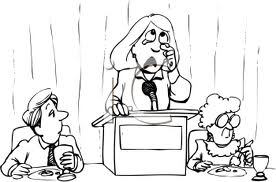
Last week I was honored by being the keynote speaker for the Women’s Luncheon at the annual Nebraska Vietnam Veteran Reunion. It is an interesting phenomenon, keynotes after eating. Most sane societies have a meal then nap for a bit. Yet, in the western world we seem to think people really want and are capable of listening to anything after ingesting a yummy luncheon. Therefore, the challenge of any meal speaker is to entertain while keeping his/her audience awake; a rather formidable task. Added to this test was the seriousness of my topic… talking about the effects of living with a spouse who is suffering with Post Traumatic Stress. Yikes!
Truthfully, this was a wonderful and unique opportunity to be with a large group of women who have endured decades of family and personal events colored by their loved one’s emotional combat trauma. The last thing I wanted was to have people leave the luncheon with more stress and upset stomachs. All of us have had way too much of these frailties. Consequently, I thought the best speech needed to be short, informative, and delivered with humor and solemnity. So here are just a few of the items I believe may be useful to strengthen the next years of these amazing women’s lives.

When I talk about the “X” Factor, it refers to what makes women, women. It is not a coincidence that women have two legs on their chromosomes to stand on versus a man’s one – “Y”. God knew we would need both legs on the “X” to stabilize us on our unforeseeable, earthly journey. Being wives, mothers, sisters… makes us caregivers and caretakers. Trauma from combat both physical and emotional makes this even more evident. “Whether it is our own mothers who stood by us in long-distance torment as we fought on foreign soil, or the mothers of the dead and wounded here as well as in Iraq and Afghanistan, we recognize that most often, it is the women—- mothers/wives… who are left to care for the broken bodies, souls, and societies left in the wake of war.”
Understanding and identifying our own actions may help protect our sanity and bodily health. Here were a few of the behaviors I asked the women to recognize and acknowledge as they interact with their loved one. Think about which of these four DOINGs you use the most:
Doing To: Blaming and Fault Finding
Doing For: Rescuing, Pampering, Becoming like the Bad Behavior
Doing NIL (nothing): Ignoring, Avoiding, Excluding, Rejecting — fuels emotions of shame in the brain
Doing With: Connecting, Clarifying, Restoring
So which category do you fall in most often? Believe me, the first three are quite easy to live in… The Doing With is much trickier to accomplish especially when you are tired, angry, and dealing with your own pain. For this reason I have adopted a powerful quote from St. Francis de Sales. I carry it in my purse. I have it on my kitchen counter, and I pasted it on my bedroom mirror.
“I made a pact with my tongue to never speak when my heart is in distress.”
Some days I am almost mute trying to practice this suggestion.
Aug
22
HEALING REUNIONS
Filed Under Events, Healing, Life, PTSD, Tears of a Warrior | Comments Off on HEALING REUNIONS
by Tony & Janet Seahorn
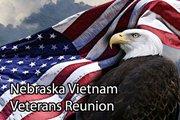
The corn is high, tasseled and almost ready to cut. Traveling through Nebraska we pass miles and miles of these tall stalks waving in the wind and looking like a legion of green sentries welcoming visitors. For the second year in a row we are returning to the Nebraska Vietnam Veteran Annual Reunion as guest speakers. It is the twenty-seventh year the gathering has been held and the attendees grow each time. Every person is welcomed… veterans, spouses, family members, and friends. Besides Nebraska, they travel from South Dakota, Kansas, Wyoming, and Colorado.

These reunions are not just reminiscing about the vet’s combat experience. They are more on being with others who have traveled a familiar road, have endured a similar past, and have formed new friendships, gained new understandings of their war events, and lived a life of service to their families and communities. The days are filled with celebrations of being – being with old buddies and new friends, being with other spouses to laugh and cry, and being in their beloved state to appreciate that this land is exactly what they fought, died, and suffered for decades earlier. Since they had no parades or welcoming ceremonies when they returned from Vietnam, they created their own event commemorating their service.
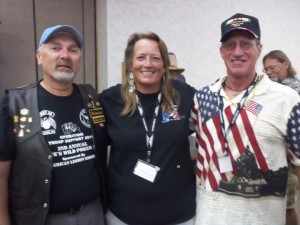 Hanging around over four hundred veterans and their families, one observes and learns many lessons and here are just a few:
Hanging around over four hundred veterans and their families, one observes and learns many lessons and here are just a few:
- 1. There really is healing in numbers.
- 2. One does not have to do the journey after combat alone. He/she has a huge posse to support the trip.
- If one person falls, there are many who care enough to pick him up, brush him off, and kick him in the butt to keep going.
- The pain and memories of combat may never go away but these memories/pain do not have to consume the entire life of the individual. Each person must make the choice to move forward in spite of their wounds.
- There is still joy in living each day.
- Laughter (and food) really is the best medicine.
- A good sense of humor gets you through a lot of grief.
And last, this special quote that we used during our workshop to support each vet and their family’s continued healing.
“The key thing to get inside the head of a PTSD suffering vet is this: If one of your buddies was lying wounded on the battlefield, you’d carry him to safety at all costs, right? Well this time, the vet wounded in his soul is the guy in the mirror, AND IT’S YOUR DUTY to carry this one more vet to help. He’s hurting because he’s a human that’s gone through an inhuman experience. Your buddies who didn’t make it back want one thing only – for one of you to make it, namely YOU. Your victory is saving that vet in the mirror, helping him forgive himself for being only human ( Roland Van Deusen).”
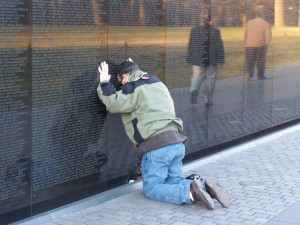
Aug
15
LUMPY GRAVY
Filed Under Life, Lumpy Gravy, Tears of a Warrior | Comments Off on LUMPY GRAVY
by Janet J. Seahorn, Ph.D
 Have you ever thought about lumpy gravy? Surely you’ve seen it, maybe even had to eat some of it. Most of us prefer our gravy to be smooth and thick, rich with the juices of the meat. So what has Lumpy Gravy got to do with PTSD? Everything! It is a pretty accurate metaphor of life and living with PTSD both as the sufferer and those closest to the pot.
Have you ever thought about lumpy gravy? Surely you’ve seen it, maybe even had to eat some of it. Most of us prefer our gravy to be smooth and thick, rich with the juices of the meat. So what has Lumpy Gravy got to do with PTSD? Everything! It is a pretty accurate metaphor of life and living with PTSD both as the sufferer and those closest to the pot.
Last night I got to thinking a lot about “Lumpy Gravy”. It all came about as Tony and I were making a turkey dinner for a friend recovering from ankle surgery. We were taking dinner over to him when we came into the dangerous territory of the Lumpy Gravy fiend. I had asked Tony to make the gravy for the meal. Unbeknownst to me, Tony had a very specific way in which he insisted on making HIS gravy. This entailed carefully putting in a handful of flour into the left over juices and stirring it until it was brown with a smooth texture before adding the extra water or milk to the mixture. However, I made the dastardly mistake of having too much liquid in the mixture. The only way to thicken with flour was to put it in a small jar filled with a bit of water, shake rigorously, and then add this concoction to the turkey drippings. As you may have now guessed, this was not the prescribed procedure. Tony responded by dumping a scoop of flour directly into the hot turkey drippings. Walla, BIG, white lumps of flour now floated proudly on top of the mixture almost taunting him saying, “You really messed this one up mister”.
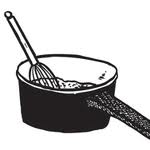
Not a big deal to the normal gravy maker. But to Tony this was not acceptable. Seeing those lumpy, white, floating sprites of flour on top of the gravy was another clever way of the PTSD troll to appear. The remainder of the evening was consumed with hashing over the problem of who, why, what, and how we now had to endure “Lumpy Gravy”.
It sounds ridiculous to most people, even a bit hilarious. Something you might view on a TV sitcom. Yet, spending the evening with the “Lumpy Gravy” demon was not entertaining or fun. It was another darn opportunity to practice patience and understanding, which can wear quite thin on some days. After settling my own temper and trying desperately to hold my tongue, which is not easy or consistently successful, I remembered what Dr. Haug, (Tony’s VA therapist) had explained to me. Tony’s behavior wasn’t about “Lumpy Gravy” at all. It was about the need to do things right, to be accurate, to be correct in the operating procedure. If one was careless and procedures weren’t followed, the operation could be in peril. As trivial as it may seem, “Lumpy Gravy” was a failure in procedure.
So what does “Lumpy Gravy” have to do with Life or PTSD? It is a metaphor of living. Enjoying smooth days that offer a richness of texture and seasoning without too many major LUMPS.

When lumps do appear in a vat of hot gravy it is nearly impossible to whisk them away no matter how vigorously we might attack the mixture. About the best we can do is to remove as many lumps as possible and hope that the gravy is still consumable. Most important is to learn the lesson of what created that “Lumpy Gravy” and try to prevent inviting the demon to dinner too often.
Next time, I am opting to buy my gravy mixture in a jar, already prepared so all that is needed is to heat it in the micro. Bon appetite you “Lumpy Gravy” demon.
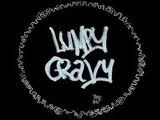
Aug
2
RIVER FISHING – GREAT THERAPY
Filed Under Combat PTSD, Events, Fishing Therapy, Healing, Healing Waters, Peace, PTSD treatment, Tears of a Warrior, Veterans | Comments Off on RIVER FISHING – GREAT THERAPY
by Janet J. Seahorn, Ph.D

There are few things in life that can take your mind off trouble more than a special day on a beautiful river. Last week the Platte Valley Trout Unlimited Chapter located in Saratoga, Wyoming had the opportunity to take a group of wounded veterans from the Cheyenne VA Medical Center on just such a trip. The excursion began with an amazing barbecue put on by members of the chapter and local volunteers. It seemed like almost everyone in the community wanted to contribute something from ice cream to napkins. Children from 4-H served food, helped clean up, and simply added their youthful energy to the evening.
The next morning began early with breakfast which proved there is nothing wrong with a warrior’s appetite. Then off to the river, which is a logistical bussle of shuttling boats, equipment and people to one of the river’s launch site. Vice-President and project coordinator of the Trout Unlimited Chapter, Steve Hays, was a bundle of nerves as he wanted to make sure every detail of this event went perfectly. Again, all the shuttle drivers, helpers, boats, and guides donated their time and efforts to making the fishing trip an amazing experience.
The guardian angels of fishing trips could not have arranged a more beautiful day for a float. The water was dazzling with light, birds seemed to have arranged their chorus of unique songs for entertainment, and even the fish were cooperative. Private angling lessons were given throughout the day which proved to be quite successful for most of the veterans. Two warriors demonstrated their angling abilities by catching ten or more fish. Since the North Platte River has been running at flood stage since mid-May, having the water and its inhabitants somewhat normal was a real gift.

Yet, the most significant result of the float trip was its therapeutic benefits to the wounded warriors. Most of the group had not known each other before the overnight trip. What they found from these precious, short twenty-four hours is recorded in their comments below:
- I can’t believe people care that much about us.
- I had no idea other veterans continue to struggle with PTSD; I thought I was just weak.
- I really needed this… it’s been a long time since I felt I could relax and feel safe.
- The whole experience has been a true blessing.
- This is what makes healing happen.
- That was one of the best days of my life.
Formal therapy can and is very helpful to many military individuals healing from the trauma of combat. But it is only one ingredient of the recipe. Being with others who have suffered similar wounds, knowing that others care and appreciate their sacrifices and experiencing the beauty and serenity of nature offers one a sense of peace, safety, and the faith that perhaps some divine presence may truly be keeping watch over them.

Yep, Fishing Therapy… the new, ground-breaking, effective line of defense against the scars of war.
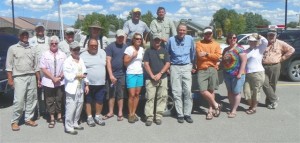
Jul
26
PERSONAL FORGIVING
Filed Under Combat PTSD, Family, Giving, Healing, Life, PTSD, Trauma | Comments Off on PERSONAL FORGIVING
by Janet J. Seahorn, Ph.D

There is a saying in the bible stating, “Forgive and ye shall be forgiven”. Yet, here’s the dicey part for many of us, some times it is harder to forgive ourselves for things we have and have not done (some of which are more perception than truth) than it is to forgive others.
Military men and women who serve in intense combat zones must learn to identify and face up to their experiences from their emotional position if they are to begin to heal. Putting “these feelings into words or some other symbolic expression”, as Bessel van der Kolk asserts, helps complete the story in a restorative manner. Everyone has things they have done that they wish could be forgotten. The problem occurs when we can’t just forget, or the personal blame continues to grow. The burden gets heavier unless some of the weight is released. We cannot be set free until we understand that we’re not fully responsible for much of the trauma that took place in our lives.
As humans, many of us tend to take too much ownership for circumstances that are far beyond our full control. We simply do the best we can, and sometimes that “best” does not feel good enough. Forgiving ourselves is an important step in the healing process. Without personal forgiveness, we hold too much anger, sadness, and anguish in our minds and bodies. It is little wonder we become emotional and physically drained.
Realistically, I do not condone the open spilling of our feelings. Sometimes when I have been overly urged to do so, I left the exchange even more vulnerable and irritated. And I definitely did not want to be in the presence of that person anytime soon. It is only when we can begin to share with someone who is open to listening and able to keep our words in confidentiality can we feel safe enough to share our story. Trust is crucial. Patience is necessary. Hope for living a better life is essential.
Daniel Siegel writes about the importance of “feeling felt” when sharing emotions. We cannot “feel felt” if, when sharing our stories, we are constantly being interrupted, interrogated for more details, or given advice on how we should or should not have acted or felt. Such disruptions only validate our instincts to suffer in silence. Unfortunately, unspoken suffering only compounds the problem and adds to the burden.
The challenge is finding the right person (or people) at the right time to begin your dialogue. For many of us it may or may not be a close family member or friend. Sometimes talking to a reliable “stranger” can bring clarity to our experience.
Begin to explore who may be your safe sounding board. In doing so, the weight of your story may begin to diminish. You may just realize that carrying this burden is no longer helpful or necessary. Free yourself of the guilt. Free yourself of the pain. Free yourself of a past that can now be accepted, learned from, and honored.
You deserve no less as you live towards that healing place in your mind, heart, and body.
Jul
19
HEALING DAD
Filed Under Combat PTSD, Healing, PTSD, PTSD treatment, Tears of a Warrior, War | Comments Off on HEALING DAD
by Janet J. Seahorn, Ph.D

It was Father’s Day and I got to thinking about all of the vets who are fathers and all of the special moments we shared as a family, as well as the times when things weren’t all that peaceful. In our book, Tears of a Warrior, we wrote that the good things far out numbered the bad. Yet, those difficult periods left lasting wounds; wounds that still remind us of the challenges of living with Post Traumatic Stress. Healing the wounds within us and the wounds inflicted on our loved ones can be a life long endeavor – a journey that poses some questions in order to mend the injuries.
First, identify who has been wounded and who do you need to help heal, besides yourself? Which relationships have been most broken by past and/or present actions? These can be spouses, children, siblings, parents, friends, and even co-workers. Identifying your “wounded group” will require a great deal of personal self-reflection and honesty. Not something most of us humans do well. Root-canals are easier to endure than admitting we have verbally harmed someone we care about due our unhealthy behavior.
What exactly needs healing? Things like trust wounds, word wounds, responsibility wounds. What actions impaired the ability of others to trust us? What did we do that makes us question if we can trust ourselves? When have we used words to inflict hurt? Interesting things – words; they can leave wounds that are longer lasting and harder to forget or forgive than many bodily injuries. Unlike physical bruises which can be seen on the outside of our bodies, words bruise the heart in ways that can neither be seen nor easily healed.
If you have been able to get this far, the difficult question of How can I mend these wounds? emerges. It isn’t important to do something huge; start with something simple which may not be all that easy. A phone call, a letter – personally I like Hallmark cards or even the new internet e-cards can be the beginning of saying I’m sorry, or Forgive Me. PTSD has been a bit like the words Jesus used on the cross, “forgive them for they know not what they do”. Because we did not know better, it was hard to do better. Most of us had no idea what PTSD was or how living through war left the veteran with residue that impacted his/her actions for years to come. Now we can get better by knowing more about the demons of combat.
Healing others helps us heal ourselves. It is a way of living forward with hope and personal forgiveness. It may be the only way we can diminish some of the demons allowing us to lead a more productive and peaceful life. Don’t wait another day to give yourself this belated Father’s Day gift. Some who have been wounded by our actions may not be ready or able to give forgiveness. This will be their journey. You can’t force forgiveness, nor can you take responsibility for it once you have assumed ownership of your own past actions. Take a deep breath, make that first step and conquer your fears and procrastinations.
“You may be disappointed if you fail, but you are doomed if you don’t try” (William Shakespeare).
Jul
11
NOW THIS IS RESILIENCE
Filed Under Combat PTSD, Life, PTSD, Tears of a Warrior, War | Comments Off on NOW THIS IS RESILIENCE
by Janet J. Seahorn, Ph.D

This is just one story of one veteran who served in World War II. We received it in a letter from a man who is approaching “89 years young”, as he proudly put it. His name is John and he wrote he has “good genes” and is of Irish and French Basque decent. What was so endearing about this letter is that it was type written, well some of it. Halfway through the letter his typewriter tape went out and he had to continue his story handwritten. The picture of this “young” man sitting at his old typewriter skillfully creating his message is really quite precious.
John’s story is much like countless military veterans. Part of his tale is chronicled in a book by James D. Hornfishcher, Neptune‘s Inferno – the U.S. Navy at Guadalcanal. This particular battle claimed the life of the first two WWII Navy Admirals killed during combat. Because his ship was in enemy territory being stalked by submarines, the rescue ship had to “put him in a metal basket, slung over the side on a long line to a destroyer”. From there he was transported to Fiji for several months of hospitalization. Eventually, John arrived back to the states where he spent over a year in rehab. But this was not the end of his healing journey. After leaving the hospital he was sent to another place in Yosemite National Park which served as a holding location for vets waiting for their discharge papers. Since there was no PTSD ward at the time, John explained, that he was “placed into a long, one room barracks building which was called the All-Messed-Up Ward”.
When John was injured, he was paralyzed on the entire right side of his body. He could not hear well nor speak much, which he humorously stated “much to the pleasure of the other patients… who wants to hear a US Marine Sergeant yak-yak”. His leg was severely injured along with loss of part of his skull. Due to his head injury he suffered many years with epileptic seizures. John admits he has struggled with PTSD (as has his brother who also served in the Marine Corp). Yet, throughout his letter there was a theme of humor, courage, and resilience. This combination of personal moral fiber aided him in living a full life.
One of the last things John wrote, I’m doing quite well, reminded me of the remarkable valor and stamina the vast majority of veterans possess. John wrote to thank us for our book, Tears of a Warrior. He said it helped explain some of what he went through during and after the war. In the end it is we who are honored to hear from someone who has endured so much, given so much in service to his country, and still continues to live with enthusiasm and pride.
Tony and I are deeply humbled to hear from individuals like John. It made those long years and challenges of writing our book worth the time and effort. And we continue to hope and believe that for everyone who has been wounded in any way during service to our country that If we send them, then we must mend them – no matter how long it takes or how much it costs.
John’s life is a testimonial to all of our military heroes.

